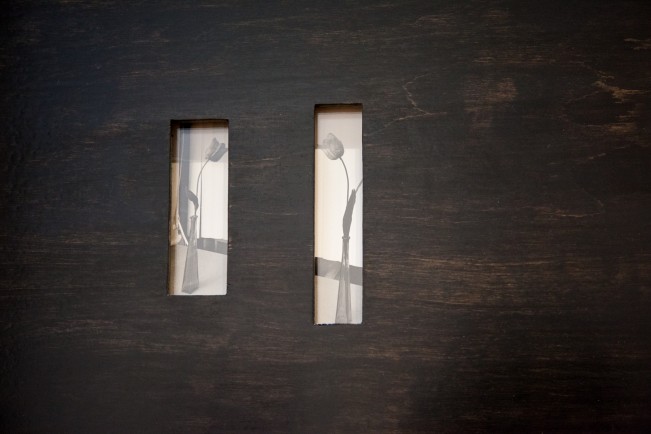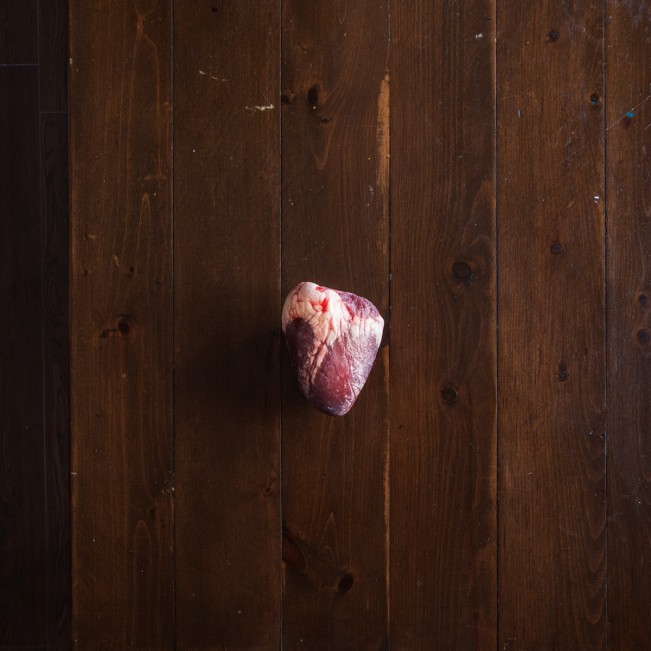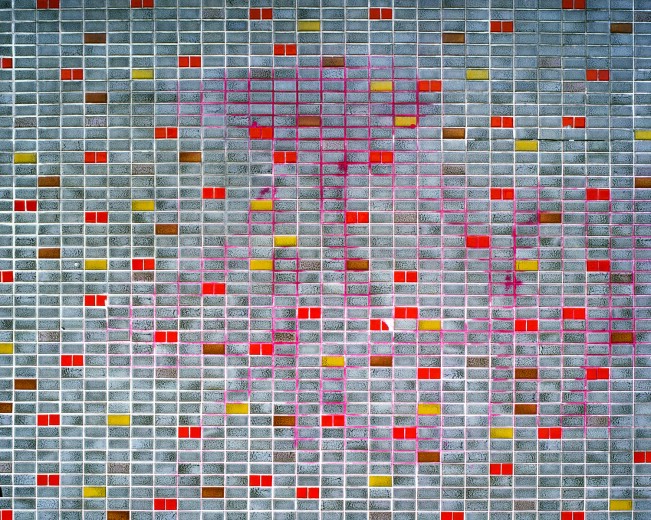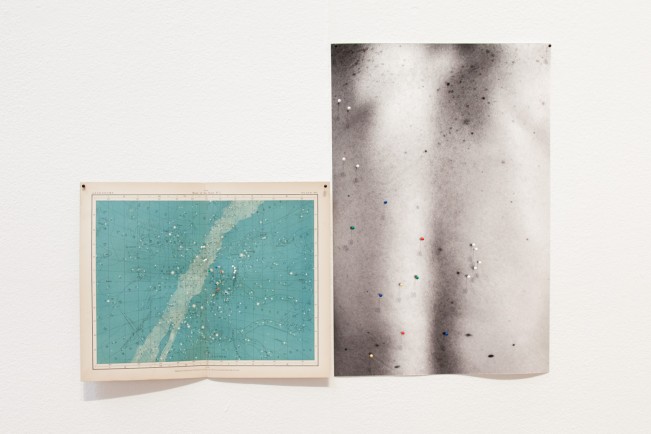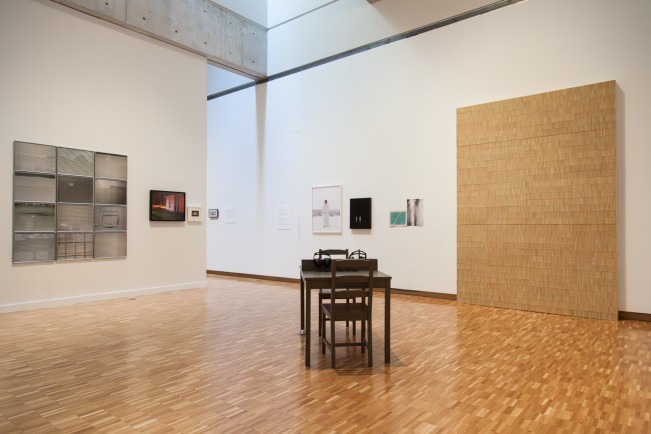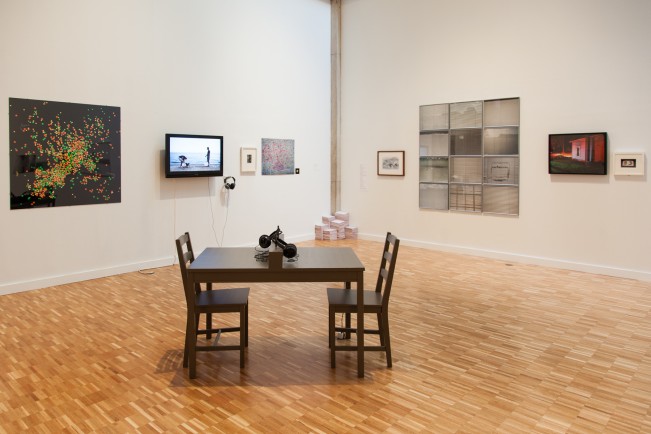Jon Horvath: Demarcations / Comedian Arts : Dramatic Ones
One of the last projects I helped work on at the Haggerty Museum of Art at Marquette University was Current Tendencies III. The exhibition focuses on local Milwaukee artists, both established and emerging. Not only does the Haggerty gather a plethora of Milwaukee’s finest, but they also use the exhibition as a platform for teaching. With this Current Tendencies being the third installment, a twist was thrown into the mix, and artists were asked to respond to pieces within the Haggerty’s permanent collect.
Today, I am excited to share an interview with my teacher and friend, Jon Horvath. Jon’s installation considers self within the confines of personal relationships, most apparent being the relationship with family. His work is filled with various allegories, romanticism, and humor, while laughter and discomfort become blurred ideas. Each piece alone holds its own weight conceptually, though it becomes increasingly noticeable, while dancing from one to the next, that the work in fact talks at one another.
Jon Horvath is an artist and educator residing in Milwaukee, Wisconsin. He received his MFA from the University of Wisconsin-Milwaukee in 2008. His work has been exhibited nationally and internationally in galleries including: The Print Center (Philadelphia), Macy Gallery at Columbia University (New York), and The Detroit Center for Contemporary Photography. His work is currently held in the permanent collection of the Philadelphia Museum of Art, and is included in the Midwest Photographers Project at MoCP . Horvath was a finalist for the The Greater Milwaukee Foundation’s 2009 and 2010 Mary L. Nohl Emerging Artist Fellowship. In 2011, he was named a US Flash Forward winner by The Magenta Foundation. Horvath currently teaches at The University of Wisconsin-Milwaukee and The Milwaukee Institute of Art & Design.
Demarcations / Comedian Arts : Dramatic Ones
This exhibition holds three titles.
Or perhaps, three fragments completing one whole.
Each title is a unique configuration of the exact same letters; they are anagrams.
You are invited to enter the space informed by any combination of the statements below.
Demarcations
Many words have many definitions.
Commonly understood as the result of establishing boundaries or revealing limits, Demarcations explores the various ways in which barriers present themselves within everyday communicative acts pertaining to both personal relationships and physical spaces. This show is an investigation into language, perception, and how we give and receive information.
Comedian Arts
Many words have many definitions.
Commonly understood as a quality that appeals to a sense of the ludicrous or absurdly incongruous, Comedian Arts explores the various ways in which comic elements present themselves within everyday communicative acts pertaining to both personal relationships and physical spaces. This show is an investigation into the complexities of the futile and the absurd.
Dramatic Ones
Many words have many definitions.
Commonly understood as a state, situation, or series of events involving an intense conflict of forces, Dramatic Ones explores the various ways in which contrast and opposition present themselves within everyday communicative acts pertaining to both personal relationships and physical spaces. This show is an investigation into the complex relationship between protection and affection.
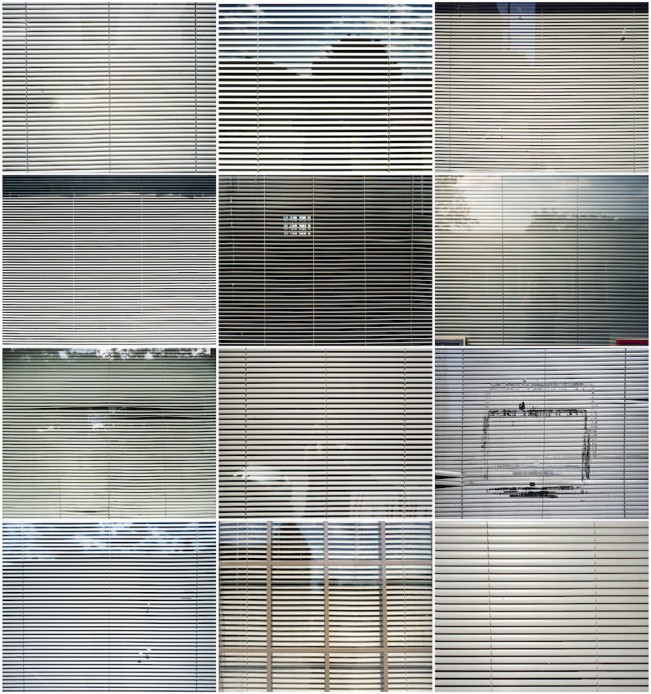 I am really interested in trying to pinpoint the beginning. Within the space there are many conversations being had, and pieces vary from subtle to loud in the references between one another. What piece was the catalyst for you?
I am really interested in trying to pinpoint the beginning. Within the space there are many conversations being had, and pieces vary from subtle to loud in the references between one another. What piece was the catalyst for you?
In many respects, I suppose there were multiple catalysts for me. As I began to investigate the museum collection, two pieces were of particular interest to me: a photographic collage by John Baldessari titled, “Five Pickles (with Fingerprints) in the Shape of a Hand” and an oil painting from the turn of the 18th century by Francesco Trevisani called, “Saint Francis in Pentinence”. As maybe expected, they are two markedly different works, but I had a substantial reaction to each. The work I made for this exhibition has a strong personal current running throughout and for the first time I began incorporating concepts of family and self-investigation into my process. While the Trevisani and Baldessari pieces hold very different cultural and historical significance, my choice to respond to the two pieces was based more in the fact that they became meditations on my mother and father.
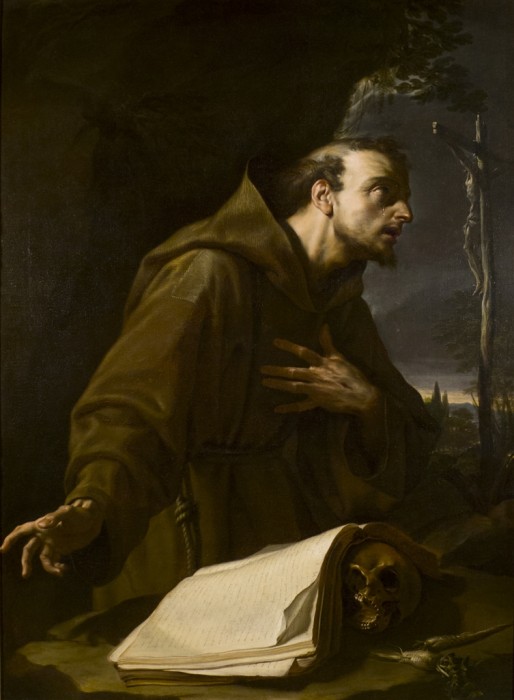
Image Courtesy of the Haggerty Museum of Art at Marquette University
Francesco Trevisani, Italian, 1656 – 1746, St. Francis in Pentinence, ca. 1695 – 1700
Upon seeing the painting of St. Francis, I immediately recalled an exchange I once shared with my mother wherein she declared that St. Francis had become her favorite saint. I found it to be a curious statement at the time because I was unaware that people took such steps to rank their favorite religious figures. The more I thought about it, though, that declaration came to reflect, in my mind, my mother’s spirit for collecting, how that characteristic of hers very much influenced me in my early years, and it became a point of focus for some of the works I made for the exhibition. So in essence, I put the Trevisani on display as a gesture for my mother, but one of the interesting things to me is that the Haggerty permitted me to change the name of the painting. Now, for Current Tendencies III, the painting is titled, “My Mother’s Favorite Saint (2013)”. For me, it’s an act of affectionate appropriation. And it inspired a counterpart portrait of my mother that also hangs in the gallery space.
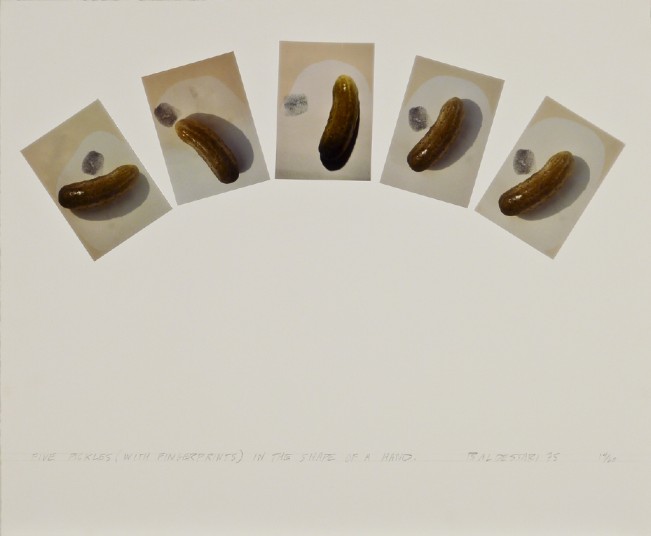
Image Courtesy of the Haggerty Museum of Art at Marquette University
John Baldessari American, b. 1931, Five Pickles (With Fingerprints) in the Shape of a Hand, 1975
The Baldessari, then, served as a metaphorical stand-in for my father. I am fully convinced that my father could have been an incredibly celebrated conceptual artist had he ever been exposed to the movement. It’s very interesting to me that I wasn’t really introduced to contemporary art until my mid-20’s, but in so many ways, I grew up with John Baldessari at my dinner table. My family’s attention to wordplay, our subversive and wry sense of humor, our appreciation for all things absurd, I see so much of that in the work of mid-20th century conceptual photographers. Simply put, John Baldessari is my comfort food. He feels like home. My father even wanted to teach me when I was growing up that peas were carrots and that carrots were peas, just to mess with me a little bit. I think that’s pretty much a Baldessari move. And while it may seem to be a slightly cruel trick to play on a child, it did teach me to question what I’m told, come to my own conclusions, and that there are many different ways to make sense of this world.
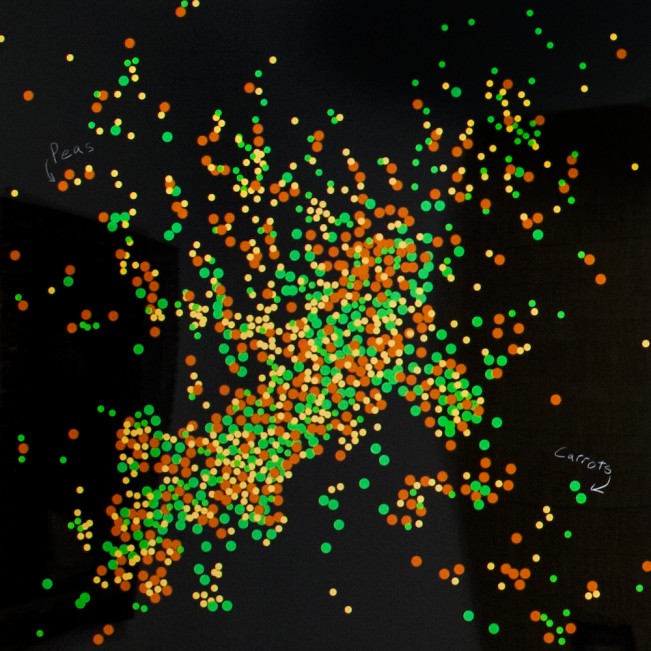 What was the evolution of the space?
What was the evolution of the space?
With the Trevisani and Baldessari pieces in place, then, it transitioned into a process of filling in the gaps between traditional high-art painting and conceptual photography, the humorous and the sacred, the sublime and the subversive, and I knew I wanted to do it through the lens of family and self-investigation. So, as I moved forward, I began to make work that considered the characteristics of my upbringing in a traditional suburban household, as well as how that environment came to influence some of my own personality traits and tendencies. Having two substantially different anchor pieces to respond to was challenging, but it was incredibly liberating. It allowed me to break free from some of the traditional constraints of making a photographic body of work. While I have a deep appreciation for working within a project structure that maintains its own visual consistencies, for this show I chose to emphasize singularity and allowed myself to utilize many different photographic languages, as well as introduce other mediums into the space including video, print ephemera, some sculptural elements, as well as an interactive audio piece. I also selected four other pieces from the Haggerty collection and used them to further bridge the gaps between my work, the Baldessari, and the Trevisani.
 You approached the prompt for the exhibition differently than most of the other artists in the show. I am talking about using the permanent collection, altering some pieces, and making them your own. Can you talk about the other altered work in the space, and do you see yourself working in this way in the future?
You approached the prompt for the exhibition differently than most of the other artists in the show. I am talking about using the permanent collection, altering some pieces, and making them your own. Can you talk about the other altered work in the space, and do you see yourself working in this way in the future?
Very quickly after receiving the prompt from the Haggerty I came to the realization that I was far less interested in utilizing the collection in a comparative way, but rather in a manner that allowed me to absorb the collection into my own working practice. So it was in an attempt to confront that premise that I originally approached the Haggerty about manipulating the presentation of some of the collection works. In addition to the Trevisani painting, I had a hand in directly altering two other pieces. One was a Lee Friedlander photograph titled Nyack, 2007 and the other a Joel Meyerowitz photograph titled New Years Eve, NYC (Kiss Me Stupid), 1965. The Friedlander is a rather traditional storefront image depicting two tulips in vases leaning towards each other. For me, the tulips came to serve as a strong visual metaphor for how I was thinking about concepts of communication in the show and that was the original impulse for including the piece. However, I was able to truly transform the work into something of my own when I built a box with two small windows in it to cover the framed print. By doing so, I obscured the vast majority of the image and introduced a physical barrier between the print and the viewer. So I was thinking about control and authority, access and prevention, and authorship with that added gesture. For the Meyerowitz, I did something similar, except in this instance I obscured the print by building up scotch tape over the surface of the plexiglass in the frame. In so doing, I only allowed certain aspects of the image to be revealed and completely changed the original intended narrative. So in my interpretation, the two young lovers are now kissing beneath a theater marquee that merely says “stupid”.
I would love to work in this manner in the future. I think it requires finding an institution that is willing to take some risks with its collection and allow for pieces to be re-contextualized and observed in an alternative manner. I’ve spoken with a few people from the museum world that have expressed interest in expanding the idea, but there is concern about permissions, and perhaps the difficulty in being granted the authority to alter the work becomes too much of a hurdle. But that makes me want to pursue this further even more.
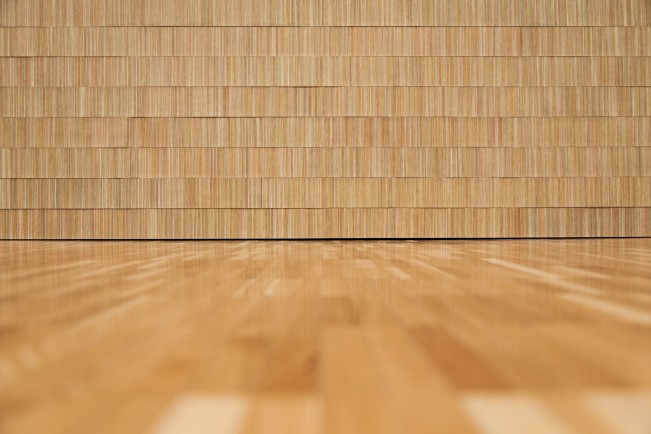 How many hours did it take to create the baseball card piece? Was it worth it?
How many hours did it take to create the baseball card piece? Was it worth it?
I could come up with a rough estimate on the total hours, but that might send me into dark place. But it is a lot. Let’s just call that piece an absolute labor of love, and oddly therapeutic. Basically, I spent the last few hours of my day for about two and a half months systematically gluing 1987 Topps baseball cards, the border of which had a faux wood pattern, one on top of another with Elmer’s glue sticks, simply to create a large fake wood panel. In the end, I used over 20,000 cards to create the piece. Was it worth it? Honestly, I can’t think of many other ways in which I’d prefer to spend my time.
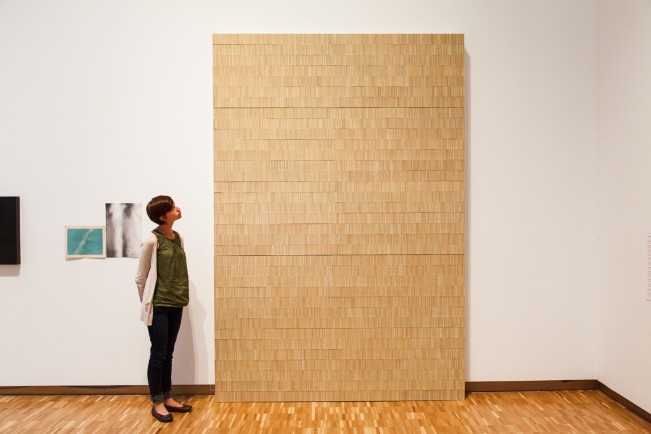 It is interesting how all the interactive pieces revolve around the relationship between you and your father. Can you expand on these conversational pieces and why they are specific to your father?
It is interesting how all the interactive pieces revolve around the relationship between you and your father. Can you expand on these conversational pieces and why they are specific to your father?
It’s true that these pieces are directly influenced by my relationship with my father, but for me, the characteristics of that relationship are somewhat emblematic of what I witness in many families, especially within the context of where I come from, a small Midwestern suburban community. Specifically, with these pieces I’m thinking about how we choose to express or limit affection within our means of communication. The two video pieces depict my father and me attempting to communicate in a non-traditional wordless manner and really consider how thoughts and emotions often times get lost in the translation into words. Then there is the audio installation that sits central to the entire exhibition installation, and for me, this piece in many ways becomes the nexus of the entire space. When visitors sit at the table, they are invited to put on a set of headphones. What they hear is the sound of my father delivering a message in Morse code by breathing it through a musical tuner. When my father was in the United States Air Force, it was his job to intercept Morse code and translate it. It’s a language that he still understands fluently to this day, but it is one that I have no familiarity with whatsoever. For this piece, then, I invited my father to tell me anything he might want to say to me, but he could deliver it through the protected language of the code. So now there exists a platform for affectionate communication where there potentially might not have been one before. At least, I imagine that it could be affectionate in nature. He also may have just read to me the ingredients from the side panel of a cereal box. I’m not certain as I have yet to translate the message.
The title of your specific show is actually three titles. Is it three separate bodies of work, or is it one collective with three titles?
In the end, I made around 15 singular, but intersecting works (I don’t really consider this a “body” of work in a traditional sense). I named the installation, itself, Demarcations / Comedian Arts : Dramatic Ones. So, technically, I gave the space three titles and provided three optional artist statements. The three titles are all anagrams for each other, meaning a simple rearrangement of the letters provides a completely different prompt for how to enter the show. The inclusion of the three titles reflects my own interest in the instability of meaning and that there are many different ways to make sense of the world based on the context in which we experience it. I guess what I’m saying is that, in fact, peas could be carrots and carrots could be peas.
I suppose some of the major themes I’m considering with these new works is where we draw lines in the world and how those lines are very often arbitrary, but still necessary. What do we choose to conceal from others and what do we choose to reveal? And how do we manipulate language and other means of communication in order to protect those interests?
Posts on Lenscratch may not be reproduced without the permission of the Lenscratch staff and the photographer.
Recommended
-
Salua Ares: Absense as FormNovember 29th, 2025
-
Ricardo Miguel Hernández: When the memory turns to dust and Beyond PainNovember 28th, 2025
-
Pamela Landau Connolly: Columbus DriveNovember 26th, 2025
-
KELIY ANDERSON-STALEY: Wilderness No longer at the Edge of ThingsNovember 19th, 2025
-
Jackie Mulder: Thought TrailsNovember 18th, 2025


